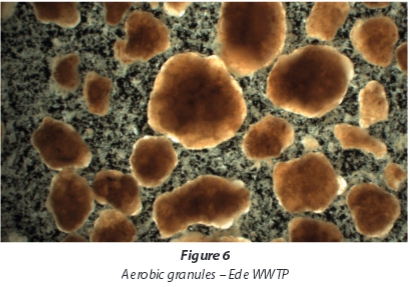
From – https://scielo.org.za/img/revistas/wsa/v41n4/11f06.jpg
Extracellular polymeric substances (EPS) play a crucial role in the formation and stability of microbial aggregates such as biofilms, flocs, and granules. These substances are essential for microbial adhesion, aggregation, and protection against environmental stresses. In wastewater treatment processes, understanding the differences in EPS composition and biofilm characteristics among various microbial aggregates can help optimize treatment efficiency and system performance.
Activated Sludge Flocs
Activated sludge flocs are aggregates of microorganisms that form in aeration tanks during the activated sludge process. EPS in activated sludge flocs primarily consist of polysaccharides, proteins, and nucleic acids. These substances provide structural integrity and facilitate the adsorption of organic pollutants. The EPS composition in activated sludge flocs is influenced by factors such as microbial community composition, nutrient availability, and environmental conditions.
Floc Composition
- Typically higher in proteins compared to polysaccharides.
- More heterogeneous composition due to the dynamic nature of floc formation.
- Can be influenced by factors like aeration, mixing, and wastewater composition.
MBBR & IFAS Media Biofilm
MBBR & IFAS systems utilize plastic carriers or media to support biofilm growth. The EPS in media biofilms is similar to that in activated sludge flocs but often shows higher diversity due to the presence of different microbial species on the media surfaces. The EPS composition in MBBR/IFAS biofilms includes polysaccharides, proteins, lipids, and extracellular DNA, which contribute to biofilm formation, stability, and pollutant degradation.
Biofilm Composition
- Generally higher in polysaccharides, creating a more stable and cohesive structure.
- Can exhibit spatial variations within the biofilm, with different microbial communities and EPS compositions at different depths.
- Influenced by media type, flow conditions, and substrate availability.
Granular Activated Sludge Granules
Granular activated sludge (GAS) granules are dense microbial aggregates that form in sequencing batch reactors (SBRs) and other high-rate biological treatment systems. The EPS in GAS granules is characterized by a higher content of polysaccharides and proteins compared to activated sludge flocs and MBBR biofilms. The EPS composition in GAS granules enhances the structural stability and aggregation ability of the granules, allowing for efficient pollutant removal and high biomass retention.
AGS Composition
- High in polysaccharides and humic substances, contributing to the granule’s stability and resistance to shear forces.
- More homogenous composition within a single granule compared to floc or biofilm.
- Strongly influenced by operational parameters like hydraulic retention time, organic loading rate, and dissolved oxygen concentration.
Key Differences in EPS Composition
- Polysaccharides: GAS granules typically have a higher polysaccharide content compared to activated sludge flocs and MBBR biofilms, contributing to their structural stability.
- Proteins: The protein content in GAS granules is also higher, aiding in microbial adhesion and aggregation.
- Lipids and Extracellular DNA: MBBR biofilms often contain higher levels of lipids and extracellular DNA, which play a role in biofilm formation and stability.
- Hydrophobicity and Zeta Potential: GAS granules exhibit higher hydrophobicity and zeta potential, enhancing their aggregation ability and resistance to shear forces.
References & Further Reading
Weber SD Ludwig W, Schleifer K, Fried J 2007. Microbial Composition and Structure of Aerobic Granular Sewage Biofilms. Appl Environ Microbiol 73:. https://doi.org/10.1128/AEM.01002-07
Wilén BM, Liébana R, Persson F, Modin O, Hermansson M. The mechanisms of granulation of activated sludge in wastewater treatment, its optimization, and impact on effluent quality. Appl Microbiol Biotechnol. 2018 Jun;102(12):5005-5020. doi: 10.1007/s00253-018-8990-9. Epub 2018 Apr 28. PMID: 29705957; PMCID: PMC5960003.
Cheng Yu, Kaijun Wang; Continuous flow aerobic granular sludge: recent developments and applications. Water Sci Technol 1 March 2024; 89 (5): 1155–1178. doi: https://doi.org/10.2166/wst.2024.055
